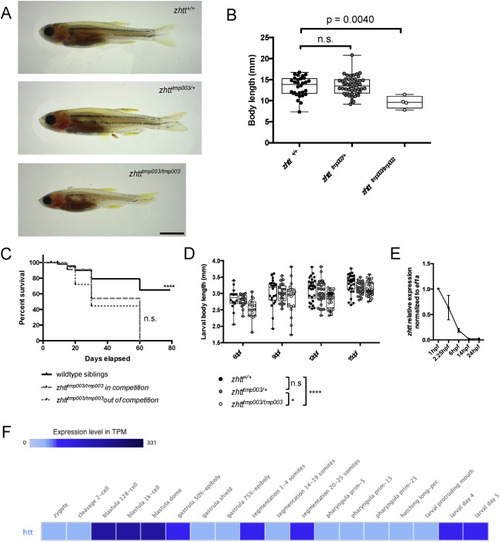- Title
-
Huntingtin confers fitness but is not embryonically essential in zebrafish development
- Authors
- Sidik, H., Ang, C.J., Pouladi, M.A.
- Source
- Full text @ Dev. Biol.
|
Generation and characterization of HTT hemizygous and knockout zebrafish. (A) Graphical representation of zHTT genomic locus and sequences of sgRNAs used for CRISPR/Cas9 editing. Red box indicates the sequences that are deleted upon CRISPR/Cas9 cutting. (B) Distal primers F1/R1 are able to detect the presence of large genomic deletion on injected embryos. (C) Representative Sanger sequencing trace of injected embryo showing that large deletion removes a large portion of Exon 1 to Intron 7 of zHTT. Truncation removes a large chunk of sequence in zHTT mRNA beyond the first ATG codon. (D) qRT-PCR analysis of zhtt mRNA expression levels of 5dpf wildtype, hemizygous, and knockout zHTT embryos. Mean values ± SEM. n = 2 pools of 12 zebrafish for each genotype. p-values determined by one way ANOVA with Dunnett’s post hoc test. (E) Morphology of 5dpf zhtt wildtype, hemizygous, and knockout zebrafish. Lateral and dorsal views. Scale bar = 100μm. (F) Genotypic ratios of progenies from heterozygous intercrosses of zhtttmp003/+. Dotted lines represent expected ratio of each genotype. Number of fish analyzed per clutch is represented above the bars. zhtttmp003/tmp003 are significantly below expected ratio at 15dpf, 1 month, and 2 months. p-values determined by Chi-square analysis.*p = 0.0265; ****p<0.0001. dpf = days postfertilization. PHENOTYPE:
|
|
zHTT-deficient zebrafish display normal iron utilization and neurulation early in development. (A) Representative images of 2dpf wildtype, hemizygous, and knockout zHTT embryos. Red arrowheads point to the hearts of each embryo. No apparent hypochromia observed. Scale bar = 100μm. (B) Representative images of 24hpf Texas Red-Dextran injected wildtype, hemizygous, and knockout zHTT embryos. Scale bar = 100μm. Measurement of midbrain (C) and hindbrain (D) widths show no significant difference in neurulation observed between the genotypes. Statistical significance calculated using one way ANOVA with multiple comparisons between groups analyzed by Dunnett’s test. PHENOTYPE:
|
|
zHTT-knockout, but not hemizygous, exhibit reduced size and survival. (A) Representative images of 30dpf wildtype, hemizygous, and knockout zHTT adults. Scale bar = 2mm. (B) Body length measurements of wildtype (N = 30), hemizygous (N = 48), and knockout (N = 4). Statistical significance calculated using one way ANOVA with multiple comparisons between groups analyzed by Dunnett’s test. Significant difference in body lengths was observed between wildtype and knockout groups. (p=0.0040). (C) Survival curves of zHTT knockout embryos when raised in competition with fish of other genotypes or out of competition starting at 5dpf. No significant difference in the lengths of survival observed in zHTT knockouts between the two treatments. Both conditions show reduced survival when compared to wildtype siblings (p <0.0001). (D) Growth curve of larval zebrafish at earlier timepoints measured from 8-12 embryos per genotype, n = 4 experiments starting at 6dpf up to 15dpf, when a large proportion of the knockout larval fish died. Significant difference in body length over time is observed between zhtttmp003/tmp003 and heterozygous or wildtype siblings (two-way ANOVA with Tukey’s multiple comparisons test, * = p-value < 0.01, **** = p-value < 0.0001, n.s. = p-value > 0.05). (E) Relative expression of zebrafish HTT mRNA normalized to ef1a expression over time in development. Data obtained by qPCR of a pool of 50 wildtype embryos per timepoint, with 2 different sets of primers to zHTT. hpf = hours postfertilization; dpf = days postfertilization. (F) Gene expression atlas data for zhtt expression in development obtained from https://www.ebi.ac.uk/gxa/home. PHENOTYPE:
|
Reprinted from Developmental Biology, 458(1), Sidik, H., Ang, C.J., Pouladi, M.A., Huntingtin confers fitness but is not embryonically essential in zebrafish development, 98-105, Copyright (2019) with permission from Elsevier. Full text @ Dev. Biol.



